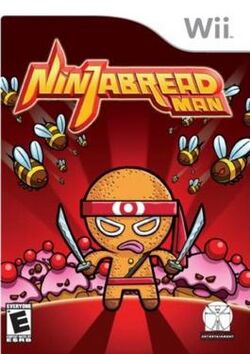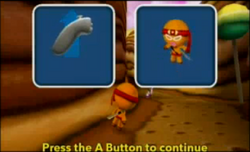Software:Ninjabread Man
| Ninjabread Man | |
|---|---|
 North American boxart, Wii version | |
| Developer(s) | Data Design Interactive |
| Publisher(s) | Metro3D Europe (PlayStation 2 and PC) Data Design Interactive (Europe, Wii) Conspiracy Entertainment (North America) |
| Platform(s) | Wii, PlayStation 2, Microsoft Windows |
| Release | PlayStation 2
|
| Genre(s) | Platform |
| Mode(s) | Single player |
Ninjabread Man is a 2005 platform video game by developer and publisher Data Design Interactive. The game was released on the PlayStation 2 and Microsoft Windows in Europe in July 2005. A port for the Wii was released in September 2007 in Europe and Australia, and on October 3, 2007 in North America. Ninjabread Man was published as part of Data Design Interactive's 'Popcorn Arcade' brand of Wii games.
Upon release, Ninjabread Man received universally negative reviews from critics due to its camera system, graphics, lack of story, short length, and controls; the Wii version received even lower reviews for its use of motion controls and is often considered one of the worst games of all-time.
Gameplay
Ninjabread Man is an action-adventure platformer. There are three levels in the game, plus a tutorial level.[1] In order to proceed to the next level, players must collect eight power rods to activate a teleporter.[2] The Ninjabread Man can attack enemies directly with a samurai sword via a shake of the Wii Remote, as well as throw shurikens from a distance using the Wii Remote's IR functionality to aim. When the player completes a level and plays it again, a menu appears with a second mode available, ‘Score Pickups’. If the level is completed again in this mode, the player will unlock ‘Time Attack’ mode. Completion of this mode unlocks the ‘Hidden Pickups!’ mode, in which the player must find pickups.[2]
Development
Ninjabread Man reportedly started development as a planned third entry in the Zool series, a 2D platforming series released for the Amiga. Not much is actually known about the pitch, though it is believed that Zoo Digital Publishing (Zool's rights owners) weren't impressed by the tech demo and pulled the license. As such, DDI released the game as a standalone original game. Despite this, evidence for the game originally being a Zool game are still present; such as leftover Zool-themed levels and items, and a since leaked intro that shows Zool crashing onto a planet that closely resembles the one used in this game.[3][4] The data indicates that each of the four games were originally worlds in the Zool demo, with Ninjabread Man being Sweet World, Rock 'n' Roll Adventures being Music World, Myth Makers: Trixie in Toyland being Toy World, and Anubis II being Tooting Common from Zool 2.
The game was first announced in November 2004 as Myth Makers: The Ninjabread Man, originally intended to be part of the company's Myth Makers series before having the suffix removed during release.[5]
Reception
| Reception | ||||||||||||||||||||||
|---|---|---|---|---|---|---|---|---|---|---|---|---|---|---|---|---|---|---|---|---|---|---|
| ||||||||||||||||||||||
Ninjabread Man received unanimously negative reviews upon release. The PlayStation 2 version of the game has a 31% average rating on GameRankings,[6] while the Wii version has an average of 17.5%.[7] On Metacritic, the Wii version of the game has an average score of 20/100, based on 6 reviews.[8] The PC version of the game was not reviewed by any major publication.[13]
IGN gave the Wii version a score of 1.5/10, saying: "It’s buggy, often completely broken, somehow manages to have frame issues in tiny levels, and is completely ruthless if (and when) younger players die."[10] Thunderbolt gave it 1/10, criticizing the game's length and the unimaginative use of the character as key flaws.[1]
Cancelled sequel
On 23 January 2008, a sequel titled Ninjabread Man – Blades of Fury was announced.[14] However, it was never released for unknown reasons and Data Design Interactive later went out of business in 2012.[15][16]
Rock 'n' Roll Adventures
| Rock 'n' Roll Adventures | |
|---|---|
| Developer(s) | Data Design Interactive |
| Publisher(s) | Data Design Interactive (Europe) Conspiracy Entertainment (North America) |
| Engine | GODS Engine, Havok, RenderWare |
| Platform(s) | PlayStation 2, Wii, Windows |
| Release | |
| Genre(s) | Platform |
| Mode(s) | Single-player |
Rock 'n' Roll Adventures is a platform video game developed and published by Data Design Interactive and Conspiracy Entertainment. The game was released in Europe on Microsoft Windows, PlayStation 2, and Wii on 17 September 2007 and in North America on 11 October 2007. The game is considered an asset flip of Ninjabread Man.
Gameplay
Like Ninjabread Man, there are 3 levels, plus a tutorial. In the tutorial level, the game will show the player what controls to use. For the rest of the levels, the player must collect all 8 Power Rods. The enemies of the game are drum parts like cymbals.
The game uses the Wii Remote and Nunchuk. Jerking the Nunchuk up allows the player to jump. Swinging the Wii Remote swings the player's guitar.
Reception
The game has received poor reception. IGN gave the game a 3.0/10, criticizing it for non-interesting graphics, sloppy gameplay, and bad controls.[17] Official Nintendo Magazine pointed out that the spine of the box misspells the title as "Rock n' Roll Adevntures".
See also
- Anubis II, a similar Data Design Interactive game
References
- ↑ 1.0 1.1 1.2 Morton, Philip (6 January 2008). "Ninjabread Man Wii review". Thunderbolt. http://www.thunderboltgames.com/reviews/article/ninjabread-man-review-for-wii.html. Retrieved 15 July 2010.
- ↑ 2.0 2.1 "IGN: Ninjabread Man". IGN. http://pc.ign.com/objects/889/889343.html. Retrieved 15 July 2010.
- ↑ "Ninjabread Man - The Cutting Room Floor". https://tcrf.net/Ninjabread_Man#Zool_Leftovers.
- ↑ "Unreleased Zool animated intro - YouTube". https://www.youtube.com/watch?v=NBxWhMcbzSk.
- ↑ https://www.gamesindustry.biz/data-design-interactive-add-3-more-playstation-2-games-to-the-myth-makers-series
- ↑ 6.0 6.1 "Ninjabread Man Reviews". http://www.gamerankings.com/ps2/929656-ninjabread-man/index.html.
- ↑ 7.0 7.1 "Ninjabread Man Reviews". http://www.gamerankings.com/wii/938506-ninjabread-man/index.html.
- ↑ 8.0 8.1 "Ninjabread Man (wii: 2007): Reviews". https://www.metacritic.com/game/ninjabread-man/.
- ↑ Lyon, James (16 October 2007). "Popcorn Arcade Roundup". Eurogamer. https://www.eurogamer.net/articles/popcorn-arcade-roundup-review. Retrieved 13 October 2020.
- ↑ 10.0 10.1 Bozon, Mark (8 January 2008). "Ninjabread Man Review". IGN. http://wii.ign.com/articles/844/844327p1.html. Retrieved 15 July 2010.
- ↑ "Test : NinjaBread Man" (in French). Jeuxvideo.com. 7 November 2007. https://www.jeuxvideo.com/articles/0000/00008196-ninjabread-man-test.htm. Retrieved 13 October 2020.
- ↑ Dickens, Anthony (4 November 2007). "Ninjabread Man Review (Wii)". Nintendo Life. https://www.nintendolife.com/reviews/2007/11/ninjabread_man_wii. Retrieved 13 October 2020.
- ↑ "Ninjabread Man". http://www.gamerankings.com/pc/944380-ninjabread-man/index.html.
- ↑ "Data Design Interactive » Highlights » Ninjabread Man – Blades of Fury". http://217.199.176.105/ddigames/?p=16.
- ↑ "NinjaBread Man 2: Blades of Fury [Wii - Cancelled - Unseen64"] (in en-US). 2020-05-01. https://www.unseen64.net/2020/05/01/ninjabreadman2-blades-fury-cancelled/.
- ↑ "DATA DESIGN INTERACTIVE LIMITED overview - Find and update company information - GOV.UK" (in en). https://find-and-update.company-information.service.gov.uk/company/03817591.
- ↑ Green, Danny (18 December 2007). "Rock 'n Roll Adventures Review - Wii Review at IGN". IGN. http://wii.ign.com/articles/841/841408p1.html. Retrieved 11 January 2011.
 |


